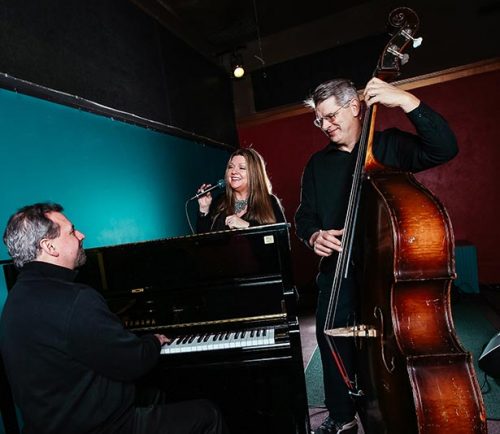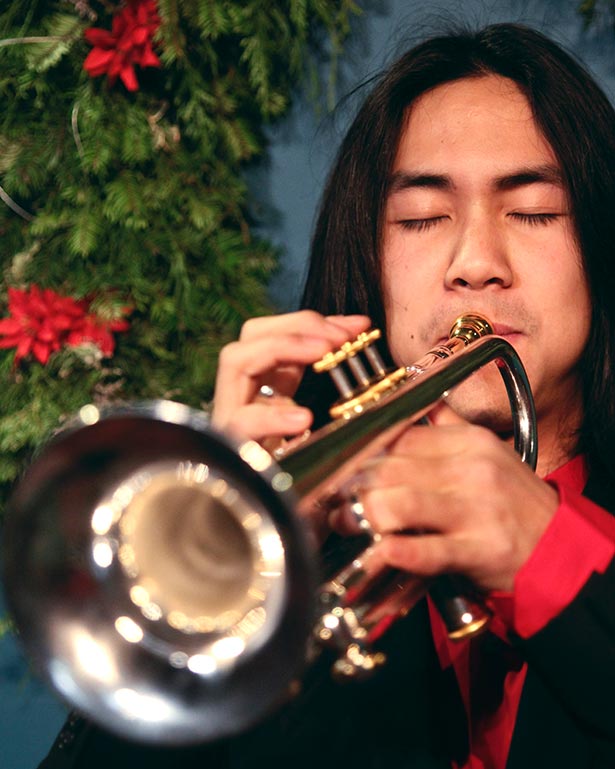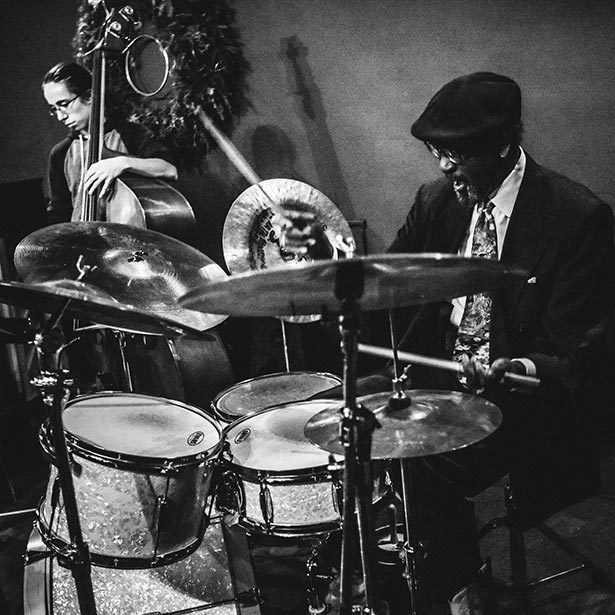
It always begins this way — with a moment of mystical clarity and ease, eyes closing of their own accord. The head starts to sway side to side with the steady pizzicato of the upright bass. A sound so open and full, you could stand in it.
Then comes the circular sound of brushes on a snare drum — fluid, guitar and piano key flavors, and finally, floating on top, a voice: Oh, I hate to see the evening sun go down, ’cause my lovin’ baby done left this town…
Jazz, at its best, is less a style of music than a state one slips into. And, as it happens, there’s a place in Eugene dedicating itself fulltime to creating such rare, holy moments.
On The Jazz Station’s stage this particular night, the voice singing “St. Louis Blues” belongs to Nancy Hamilton, an oft-featured vocalist of remarkable depth and agility. She furrows her brow slightly on the highest note, microphone held close to her mouth, while her husband, John Crider, plays piano behind her, in sync with guitarist Spencer Doidge. Chris Orsinger, the man plucking the upright bass, smiles with satisfaction.
Orsinger and the Hamilton-Criders are among The Jazz Station’s original founders, and the whole band is quite familiar with the dynamics of this club, where the air is always thick with the dark, lush heaviness of a crowd saturated with one desire: diggin’ on jazz. Many nights, there’s not an empty seat to be found in its downtown Eugene storefront, and competition for groove space on the dance floor is cutthroat.
In short, The Jazz Station is the Eugene jazz community’s watering hole — a dynamic center connecting players and listeners alike.
The venue has grown quickly since its creation in 2005, becoming regionally established and sought after by touring artists. It continues to support local performers in addition to packing the house for bigger acts, and it also offers workshops, rehearsal space and recording equipment.
Reaching The Jazz Station’s current status was the work of an impassioned few, and that few has grown exponentially — though flexibility of genre boundaries may be needed to keep younger generations involved in coming years. This country’s great Jazz Age of the 1920s is long past, of course, and it could be that if the genre itself is to remain vital, it must adapt and evolve to capture the imagination of new listeners while retaining its traditional audience.
Birth of the Cool
The Jazz Station is equal parts musical excellence and community culture, and it’s become the envy of some cities twice Eugene’s size. Its beginnings, though, were humble to say the least. The club was borne of a basic need among jazz players for a space to jam, practice and perform — at a price suited to a musician’s meager budget.
“John and Nancy and I were playing gigs around the area from about 2004 on,” says Orsinger, former president of the Willamette Jazz Society (WJS). “Basically, we’ve always loved talking about ways we could make it better — better opportunities to play that really helped jazz grow. And then I get a call from John and Nancy, and they say, ‘Well, we’ve rented a little place downtown, and will you help us put on some shows this summer?’”
Orsinger, who is also the executive director of the nonprofit Friends of Buford Park and Mt. Pisgah, immediately saw greater long-term potential in the idea. He suggested that WJS take responsibility for the venue, allowing for stability and tax-deductible donations. He whipped up a membership form detailing monthly, recurring donations and “talked up” the project to his network of players, eventually rounding up enough memberships to secure the first few months’ rent.
On July 21, 2005, The Jazz Station opened in its original location: a 700-square-foot shoebox of a room at 67 W. Broadway, complete with stage lights fashioned from coffee cans.
Ted Ledgard, a current Jazz Station member-volunteer, remembers the first venue as “so limited in space that you couldn’t get more than about 10 people in this place. So you’d have two or three musicians playing, with the audience sitting 5 feet away … it was all going on, right there in your lap.”
But, as Ledgard says, “It grew, in spite of itself.” The space proved perfectly conducive to Sunday afternoon open jams — The Jazz Station’s first regularly scheduled event — as well as establishing the venue as a place for jazzers in Eugene to build relationships.
“It was where the community developed its roots,” says Orsinger, who watched John and Nancy get married at the venue in 2006.
Orsinger assumed from the start, though, that the operation would outgrow its location. The jazz community’s burgeoning solidarity came with a growing desire to perform and, as audience numbers swelled, the necessity for more space kept nagging.
A Love Supreme
On April 1, 2011, an all-new Jazz Station opened further west on Broadway with a relatively roomy space of 2,500 square feet.
In addition to continuing Sunday jams, the new venue began producing live shows Thursday through Saturday as well as hosting First Friday ArtWalk receptions and member get-togethers.
Here, the stage was set up with bona-fide track lights, while the main floor had seating for 70. The room was lit by delicate paper-maché light fixtures wall-mounted among a rotating art exhibit, and the walls themselves matched the full-bodied red of the wine served at the new bar by the entrance.
The digs may have been less classic-cool than the busy, smoky jazz clubs of yore, but it was a nice place. Things were looking rather rosy for The Jazz Station.
 |
|
Tumpet player Parkpoom Aempoo playing with Eugene Composers’ Big Band. Photo by Athena Delene
|
The transformation was, however, not without its growing pains. The renovation costs totaled more than $30,000. After gaining $5,000 in supporter contributions, another $22,000 in loans still had to be secured; one $15,000 chunk was acquired from the city of Eugene’s Downtown Revitalization Loan Program.
The spike in rent at the new address also required an intensive push for membership, not to mention a push for existing volunteers to help build the place, as plumbing and electricity were the only things WJS could afford to install professionally.
With the help of a few dedicated souls, retired jazz historian and WJS volunteer Robert Sposato created The Jazz Station that exists today — from building the stage to painting the walls — and he still stops by to make touchups.
Sposato also recently took on a series of biweekly Jazz Station shows focusing on classic, melodic arrangements; he says he spends “five or six hours every morning” organizing these shows.
Fierce spirits of volunteerism like Sposato’s are, in essence, The Jazz Station’s lifeblood, seeing as no one involved in WJS makes any money.
The time and effort Sposato dedicates to The Jazz Station has been frustrating at points, but he finds it worthwhile to stay active in ensuring the club’s growth.
“It’s got everything right,” he says. “It’s got a good lease, not expensive. It’s in a good town; incredible musicians, a big enough jazz base of audience. They should be packing the audience just about for every show by now.”
My Favorite Thing
Ledgard and Rieser agree that the strongest force contributing to the building of the organization’s momentum over the past few years has been, quite simply, “the quality of the music.”
After spending even one night at The Jazz Station, it’s clear why musicians play well there. Unlike other Eugene venues that provide occasional jazz, Jazz Station audiences listen actively rather than focus on food, drink or conversation.
The acute audience attention given to each musician on stage directly affects the nature of the exchange. And since jazz stands alone in its ultimate dependency on real-time improvisation for its power, the already symbiotic performer-audience relationship is all the more essential.
“It is, to me, a spiritual practice,” says Orsinger, who adds that any time he plays bass at The Jazz Station, he’s influenced by the power of deep, mutual respect and reverence for the present, an element he considers integral to the jazz art form.
“When audiences listen, musicians play better. Period. Especially in jazz,” Orsinger says. “This is what these people are offering. They’re offering all these years of preparation and excellence.”
From a performance perspective, Orsinger is not alone in his preference for The Jazz Station.
Vocalist Halie Loren, a Eugenean of 15 years, has gained world-class recognition over the past decade; she’s been featured in such major publications as Jazz Times and All About Jazz and was recently rated Billboard Japan’s No. 1 jazz artist. Even with her international success, Loren says playing a venue that equals The Jazz Station’s attentiveness and intimacy is a rarity.
“There aren’t a lot of strictly listening venues, just in general, unless they’re the larger concert halls,” she says. “The Jazz Station is, like, this great music club.” She adds, “The U.S. in general is losing them, just in droves.”
The decline in jazz venues that Loren notices may hold true nationally as well, but its occurrence in the Pacific Northwest is undeniable, and the evidence hits dishearteningly close to home. For instance, in the past year alone, Portland has seen three jazz clubs — Blue Monk, Ivories and TaborSpace — shut their doors.
If there’s a silver lining in the shrinking of Portland’s jazz club scene, it’s the space it leaves for smaller, homegrown venues to become West Coast jazz destinations.
For instance, Carl Woideck, UO jazz history professor, host of KLCC’s “The Soul of Jazz” radio show and a locally gigging saxophonist, says he’s perceived an interest from the Portland jazz community “to create something like The Jazz Station — a nonprofit musicians’ society that would help sponsor gigs and be a support system for musicians. And so far, they’ve found it really rough-going. So I would say that Eugene, although it’s a much smaller market than Portland, does have something that Portland does not.”
The spillover of Portland audiences looking for jazz may benefit The Jazz Station short-term, but as “jazz fusion” becomes more pop than jazz and straight jazz’s slice of the popular music industry keeps shrinking, there’s much more at stake than The Jazz Station’s name — or any venue’s name, for that matter.
You Make Me Feel So Young
Woideck says that in his interactions with college-age students, it seems what keeps many young people from engaging in jazz is that “in many cases, jazz is perceived as being an abstract music that’s difficult for people to understand.”
There are myriad cultural factors that could explain this popular conception: jazz studies programs in higher academia pushing for cerebral virtuosity; contemporary artists (such as award-winning trumpeter Ambrose Akinmusire) playing jazz so abstract and experimental it limits its listenership to jazz players; or, plainly, the ineffable condition of a trend-driven popular culture. Maybe the Jazz Age has passed, and that’s all.
Whatever the case may be, the American jazz tradition can only be perpetuated by finding ways once again to catch the ear of the purely recreational listener — the same fan who grabs onto the singable melodies and danceable percussion of pop music.
In its heyday, jazz was “a very social music,” Woideck says. “People, you know, dated to jazz. It was America’s popular music.”
But any social music begs for a social atmosphere to be played in, and maintaining support of community-centric, all-ages venues like The Jazz Station is an important step on the path to reclaiming jazz as a popular genre.
 |
|
Drummer Kenny Reed and his Stone Cold Jazz Band. Photo by Todd Cooper.
|
Less stuffy than a concert hall, less dingy than a bar, The Jazz Station is where “large crowds find the music really accessible, really approachable,” Woideck says.
One problem is that, according to Rieser, while younger fans are often in attendance, it’s spotty, and The Jazz Station’s consistent core of audience members lacks young folks. Rieser seeks to engage with younger generations by pursuing strong relationships with Eugene’s universities. Any time UO jazz ensembles perform off-campus, it’s almost always at The Jazz Station, and some professors assign Jazz Station performances to the combo groups they coach.
The Jazz Station has yet, however, to become as involved with area high schools, which Rieser describes as having “some very good players … there’s three from South Eugene High School that are all, I would say, bordering on professional quality.” His plans for future outreach include summer jazz camp scholarships and, potentially, a band of Jazz Station regulars that would perform standards at area high schools.
But even after getting as many young bodies into the place as possible, Rieser says he realizes that accommodating today’s young consumers may also require a looser definition of “jazz.”
“We’ve looked at branching out a little bit repertoire-wise. Like jazz with a little bit of hip hop thrown in,” Rieser says.
The Shape of Jazz to Come
Much like jazz itself, The Jazz Station’s path forward is by no means straight and narrow. Rieser and his board plan to beef up grant writing, use rehearsal and recording spaces more heavily, offer more visiting artist workshops and continue to book bigger names. If sold-out shows become more common, the board has discussed moving to a larger space in the future.
What the music will sound like down the road, though, is debatable. Loren, known for her cross-genre aesthetic, says she thinks jazz in the coming years will most likely sound less and less similar to the traditional, melody-driven structures of vintage jazz standards.
“Like anything genre-wise, it evolves,” Loren says. “It changes, it moves with the times in order to stay relevant.”
Even people like Ledgard, who’s been listening to jazz since 1952, may be adapting to a departure from the classic sounds they’re accustomed to. The more groove-based, avant-garde styles of recent days do indeed sound wildly different, but at least they’re keeping jazz around.
“I will say this,” Ledgard says, “that our younger musicians are playing jazz that I don’t understand. But that’s OK. They’ve just taken it to another step, another level. You know, they’re just doing what [“free jazz” pioneer] Ornette Coleman did 35, 40 years ago.”
This acceptance of change plays into the overall culture The Jazz Station seeks to foster. “Here’s a place for intergenerational exchange of information — of culture,” says Orsinger, face lit with an excited smile. “The telling of stories — that’s part of keeping jazz alive.”